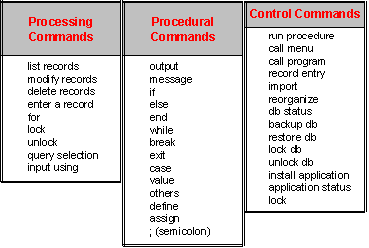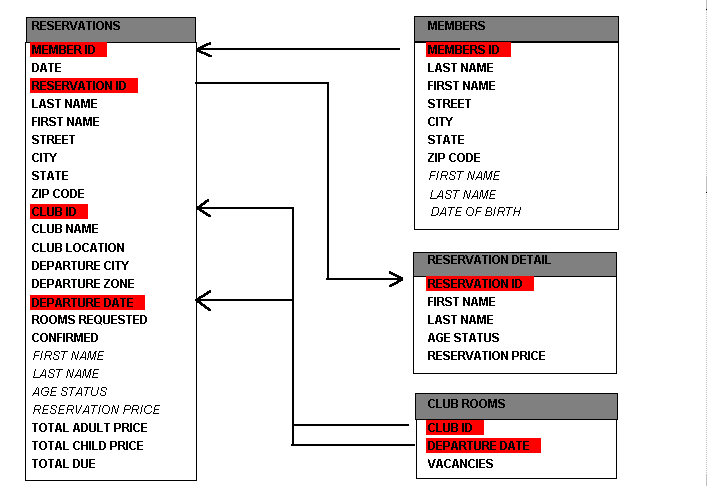



In addition to generating simple reports like the list records example described in the preceding chapter, the DataEase Query Language can also be used to link documents and database processing procedures together to manage an application. By combining DQL control structures and processing commands, you can easily navigate from one document to another and automatically add, process, manipulate, and delete data from multiple database tables without manually keying the information into each and every record.

To control all aspects of an application, the DQL is divided into three groups of commands (see list above):
Processing Commands are used to add, modify, delete, or display the data in the application.
Control Commands are used to manage access to the documents in the application.
Procedural Commands are used to organize and control the flow of actions in a DQL Procedure. These commands can be used to conditionally invoke Processing and Control commands.
Note: In the character-based version of DataEase, DQL processing is divided into two different types of procedures: Control (program control) and Processing (database manipulation) procedures. Although DataEase does not require you to divide your scripts into separate Control and Processing procedures, doing this makes your scripts easier to understand and enhances concurrent access to data.
The automated Club ParaDEASE reservations system discussed in this chapter has been divided into three Processing procedures and a Control procedure to facilitate understanding, but all the commands could be combined in a single script. Other benefits gained by dividing the Club ParaDEASE reservations system into several DQL Procedures are discussed at appropriate places throughout the chapter.
This chapter is designed to demonstrate every element in the DataEase Query Language in a realistic context. The chapter shows you how to use many basic programming techniques such as processing loops, variables, and data manipulation functions to manage a complex business application.
The examples in this chapter show how to combine DQL Processing, Control, and Procedural commands, into a powerful procedure that is used to control the entire Club ParaDEASE reservation system, including illustrations on how to maintain an inventory of available rooms at each club, calculate discounts, and generate invoices. Although your application may be very different, the manner in which you use individual commands is similar regardless of the type of business you are planning to automate.
The examples in this chapter use the set of tables shown below. The RESERVATION DETAIL and CLUB ROOMS forms are standard, single-level forms. The RESERVATIONS form is a Multiform; the fields shown in italic are actually a view of the RESERVATION DETAIL Subform. The MEMBERS table is also a Multiform; the fields shown in italic are a view of the FAMILY MEMBERS Subform. Tables that have a predefined relationship are indicated by the connecting lines. Relationship Match fields are shown in bold.


Product: DataEase for Windows 7.x. Written by George Washington 11/04/14 at 08:26:17

Product: DataEase 8 Reporter. Written by eduardo paez 02/05/14 at 14:40:11

Product: . Written by Marco Marchesi 15/02/16 at 14:50:46

Product: . Written by Grossi Gioacchino 18/11/19 at 14:33:44

Product: Dataease [{8}]FIVE. Written by Rainer 22/03/21 at 11:13:10

Product: Dataease [{8}]FIVE. Written by Rainer 08/06/21 at 14:12:40